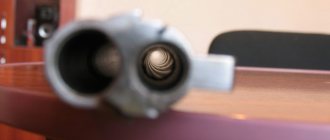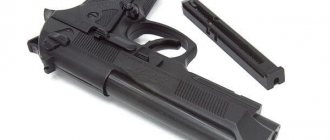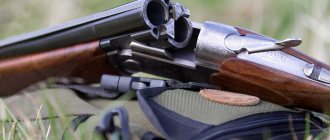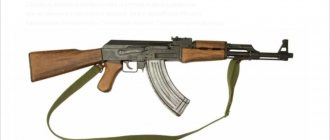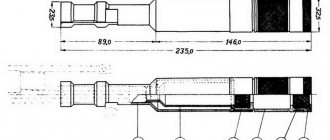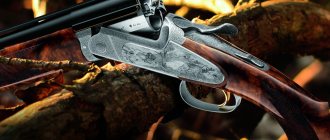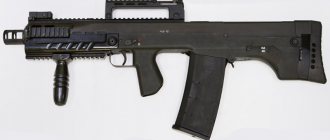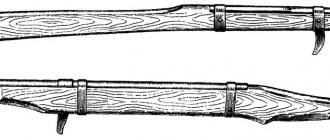The invention of gunpowder can be called the most important event that changed the course of world history. Firearms, having completely replaced cold weapons over several centuries, became the main instrument of warfare. It remains so to this day... Over the past five hundred years, it has come a long way, from primitive muzzle-loading fittings to modern assault rifles. Parallel to this process was the evolution of ammunition. One of the main milestones in its development is the creation of a rifled barrel, which greatly increased shooting accuracy.
It is believed that rifled weapons first appeared in Europe at the end of the 15th century, although we do not have accurate data about this truly historical event. Despite this, until the first half of the 19th century, rifled weapons were not widespread. This state of affairs changed radically only towards the end of the century before last.
In Russia, the designation “rifle” was officially adopted only in 1856. It meant a short-barreled rifled weapon; before that it was called a fitting or a screw gun. It can be added that in Russian the word “gun”, as a rule, means a smooth-bore weapon, while a rifled weapon is called “rifle”.
Currently, the vast majority of military firearms are rifled. Exceptions are quite rare. For example, the use of smooth-bore guns has returned to use in tank building, and similar barrels are also used in artillery. Rifled weapons for hunting are also very popular, although weapons with a smooth barrel are also used for this purpose.
However, before talking about the history of the development of rifled weapons and its modern models, it is worth saying a few words about the barrel rifling itself, the functions they perform and their classification.
Why are rifling needed at all?
The barrel is the most important part of any firearm. It gives the bullet translational and rotational movement in a certain direction. We can say that the ammunition and barrel determine the basic ballistic characteristics of any small arms.
The rotation of the bullet is especially important, and if it is desirable for a round bullet, then for an oblong bullet it is simply necessary. Such a bullet, fired from a smooth-bore weapon, will immediately begin to tumble randomly. The fact is that its centers of gravity and the application of aerodynamic forces do not coincide, therefore, without the stabilizing gyroscopic effect that rotation creates, an elongated bullet is not capable of maintaining its position in space.
The barrel of a rifled firearm consists of a chamber, a connecting cone (or bullet entry) and a rifled part. The cartridge is fixed in the chamber before firing; in its shape and size it repeats the cartridge case. The connecting cone is necessary for the correct insertion of the bullet into the rifling of the barrel; the dimensions of the rifling in it gradually increase from zero to the usual size characteristic of a particular type of weapon. The rifled part of the barrel gives the bullet a rotational motion, which subsequently stabilizes it in flight. At the moment of firing, the bullet casing or the leading belt of the projectile fits tightly into the rifling, which prevents the breakthrough of powder gases between the bullet (projectile) and the walls of the barrel bore.
Rifles are grooves that run along the surface of the bore, from the connecting cone to the muzzle. Each such groove has a bottom and two sides. The spaces that protrude between the rifling are called rifling margins. The edge that “guides” the bullet is called the combat edge; it is clearly visible from the breech of the barrel. The edge opposite to it is called the blank edge; it is visible from the muzzle of the barrel. In some countries, the caliber of a rifle is the distance between the opposite fields of the rifling, in others it is calculated by the distance between the bottoms of the rifling.
The cutting of the trunk can go from left to right or curl in the opposite direction. This does not particularly affect the combat characteristics of the weapon. The direction of the rifling in different countries is determined rather historically; in Russia (USSR), the USA and Germany it is right-handed, and in England and France it is left-handed.
The smaller the rifling fields, the easier it is for the bullet to penetrate into them. However, if their value is less than necessary, then the bullet may break off from the rifling. On the other hand, excessive channel depth can cause the bullet casing to rupture or shatter. In addition, deep rifling creates significant protrusions on the bullet casing, which worsens its ballistic characteristics. Taking into account all of the above, the depth of rifling is usually made equal to 1/50 to 1/70 of the caliber of the weapon. Initially, the fields made fewer riflings themselves, thus reducing barrel wear, but after the advent of more durable materials, this practice was abandoned.
Manufacturing
The rifling is a long helical groove running along the bore. The cutting can curl both from right to left and from left to right. Each cut has two sides and a bottom. The edge on which the bullet rests when twisting is called the combat edge and is visible from the breech of the barrel. The opposite edge of the rifling is called blank and is clearly visible from the muzzle of the barrel. The spaces between the rifling are called rifling margins. At one time, the margins were made much narrower than the rifling itself in order to reduce barrel wear (in this case, the bullet, standing on the rifling, was less deformed and, accordingly, less abraded the bore when passing through it), for example, the Berdan rifle had rifling three times wider than the margins; however, with the advent of better materials, rifling began to be made as wide as the margin, or even narrower. The diameter of the bore along the fields is called the bore caliber. In some countries, the caliber of a barrel is usually determined by the bottom of the rifling.
Basically, rifling is created in one of the following ways:
- cutting rifling one at a time while pulling a special cutter;
- cutting all the grooves at once using a special cutting tool;
- pressing through the rifling using a mandrel;
- forging a barrel placed on a core with a mirror-image rifling matrix;
- casting a barrel around a core with an applied matrix;
- electrolytic leaching of metal at the rifling site using a matrix of dielectric material;
Mandrelization gives a very rough treatment of the barrel bore, but it is done quickly and is cheap, in addition, it somewhat strengthens the barrel bore due to the formation of hardening when pushing the mandrel. Barrels of smooth-bore and rifled weapons, manufactured using the “cold forging” method, provide a more stable fire and increased wear resistance of the bore with low manufacturing time. However, quality barrels, especially for sporting guns, are made almost exclusively by broaching the cutter. For artillery barrels that have a relatively large caliber, it is often advisable to use the electrolytic method.
What types of rifling are there?
There are a large number of barrel rifling profiles: trapezoidal, rectangular, rounded, segmented, etc. In a rectangular rifling, the side edges of each rifling are parallel, in a trapezoidal rifling they are located at an angle to each other. Segmental rifling is part of a circle segment, etc. Rectangular rifling is most commonly used in weapon systems. They are reliable, durable and relatively easy to manufacture. Trapezoidal rifling is more complex and expensive to produce, but they provide better accuracy. It is even more difficult to produce a barrel with rounded or segmented rifling.
In different historical periods, other barrel rifling profiles were used. For one reason or another - usually because they are labor intensive or expensive - they are not widely used. For example, in the middle of the 19th century, the English engineer and inventor Joseph Whitworth proposed the so-called polygonal cutting of the barrel. In cross-section, it resembled a regular polygon; bullets for it were also supposed to be made in the shape of a twisted prism. Due to the high cost of production, this design was not widespread. Among modern weapons with a polygonal barrel rifling, we can note the American-Israeli Desert Eagle pistol.
Another important characteristic of the rifling of the bore is its angle of inclination or steepness. They determine the pressure of the bullet on the combat edge of the rifling and, accordingly, the wear rate of the weapon barrel. The most “advanced” are considered to be rifling with a progressive steepness, which significantly improves the accuracy of the weapon. However, due to the complexity of manufacturing, they are not widely used and are used only in a small number of sniper systems.
Speaking about rifled weapons, it should be understood that when passing through the barrel bore, the bullet fills it completely, to the very bottom of the rifling. To achieve this, the cross-sectional area of the bullet is slightly (1-2%) larger than that of the barrel. If it goes down the barrel freely (“with play”), then this leads to deviation from the aiming direction and damage to the barrel bore. In this case there is no need to talk about accuracy at all.
In general, the “correct” manufacture of the barrel is of utmost importance for the accuracy and accuracy of the weapon. Roughness, roughness of processing, uneven bottom of the rifling can reduce these indicators by 20-30%. The very first shooting of a rifled weapon will show such flaws.
The evolution of rifled weapons: how it all began
In Europe, the first firearms appeared in the 14th century. At first it was all smooth-bore. These were primitive heavy hand-handles and latches, as well as bombards, which were used to destroy fortress walls. It is believed that the first weapon with a rifled barrel appeared at the end of the 15th century. Although, data about this event is quite vague. According to one version, this event happened in Germany, according to another - in Austria. There is also a hypothesis about the Italian origin of rifled weapons. Initially, the rifling was straight and they were probably needed to reduce contamination of the barrel bore with gunpowder, which at that time was of extremely poor quality and did not burn completely when fired. Later, already in the first quarter of the 16th century, they decided to make screw rifling, which significantly increased the accuracy of the weapon. Already in the middle of the 16th century, there were not only hand-rifled firearms, but even cannons with a rifled barrel. Several of them have survived to this day. However, despite the excellent shooting accuracy, rifled weapons have not become widespread. And there were very good reasons for this...
The main problem of the first fittings and rifles was the great difficulty of loading. It was fired from the muzzle of the weapon, and in order for the bullet to fit into the rifling as needed, it had to be literally driven into the barrel. First, an oiled rag was placed on the muzzle, and then a bullet was placed on it, which was then driven into the barrel using a wooden hammer and ramrod. The patch greatly facilitated this process and at the same time prevented the lead from clogging the rifling too much. But you had to know when to stop - if the bullet was clogged too much, then the gunpowder ignited worse and the shot was weaker. Therefore, ramrods were sometimes equipped with special transverse stops that prevented them from going too far into the barrel. Now imagine that all of the above manipulations must be done not in a shooting range or shooting range, but on the battlefield, under enemy bullets and buckshot. The pleasure is below average... The great Napoleon said that watching soldiers armed with guns shoot is sheer torture.
It cannot be said that smooth-bore weapons of that era loaded quickly and freely, but there was clearly less hassle with them. And the service life of the threaded fittings was short. It was enough for 100-200 shots. The ramrod damaged the rifling; they became clogged with lead and scale. In addition, rifled guns and cannons were more expensive to produce than their smoothbore counterparts.
The design of the rifling itself was also imperfect. As a rule, the bullet was imprinted very firmly into them, so the pressure and temperature in the breech of the weapon was higher than that of smoothbore guns. Consequently, rifled guns had to be made more massive. Sometimes the problem was the opposite situation, when a round bullet weakly grabbed the rifling and flew off when fired. Due to the discrepancy between the bullet and the rifling (stiff motion or stalling), it was impossible to use a large amount of gunpowder, so the firing range of early rifled weapons was low.
The best minds in Europe have been working on improving rifled weapons for several centuries. A book was published in Madrid in 1644, which discussed the characteristics of various types of calibers. In the middle of the 17th century, the Englishman Benjamin Robbins, a member of the Royal Society, made a report on the theory of rifled weapons. True, this did not force the English generals to pay more attention to him.
Engineers regularly experimented with new types of rifling. At the beginning of the 17th century, weapons usually had a large number of shallow and flat rifling, their number could reach up to 32. In 1604, Balthasar Drechsler replaced the round rifling with an acute angled one. It held the bullet better, but it tore the plaster, and besides, such rifling quickly wore off. In the middle of the same century, guns with deep and sharp rifling appeared, which in cross-section resembled a star with six, eight or twelve rays. But such cuts also quickly became clogged with carbon deposits or lead, and cleaning them was very problematic.
Today, a circular cross-section of the barrel bore seems to us the only possible one. Meanwhile, this is not entirely true. In 1788, the Tula gunsmith Tsegley created a rifle with a triangular bore. Naturally, the bullet had the same shape. Previously, Europe had experimented with a square bore. Such bullets easily slid along the barrel, that is, the weapon was loaded quickly, the barrel was easy to clean and had a significant service life. And, of course, a bullet of this shape could not escape the rifling. True, its ballistic characteristics were unsatisfactory, so such weapons did not become widespread.
The New World made a significant contribution to the development of rifled firearms. European settlers actively populated the vast and undeveloped territory of North America. They lived among wild, virgin nature, so it is not surprising that precision rifled hunting weapons were very popular among them. Even before the advent of their own state, Americans loved to shoot and did it very skillfully. The Kentucky rifle was not only an important step in the development of firearms, but also played a significant role in the independence of the United States.
This weapon was born in the 30s of the 18th century, and not in Kentucky (there was no such state then), but in Pennsylvania. It had a relatively small caliber for that time - from 10.2 to 11.45 mm, which saved both lead and gunpowder, as well as an unusually long barrel, which made it possible to fire at distances significantly exceeding the range of smoothbore muskets. The most interesting thing was the rifle's loading system. The bullet was made smaller than the caliber of the barrel, after which it was wrapped in a piece of well-oiled leather. So it freely entered the barrel, which significantly speeded up loading. In addition, the “lubricated” bullet easily slid along the rifling when fired, which made it possible to reduce the weight of gunpowder, and, therefore, make the barrel and fore-end relatively thin and light. The Kentucky striker mechanism was very simple and could be repaired even in the field. Well, most importantly, this rifle was very accurate.
And if the British with their famous “Brown Bess” musket could conduct aimed fire at about 90 meters, then the Americans could easily hit them from 180-200 meters. Huge losses from the well-aimed rifle fire of the colonists forced the British military to appeal to Parliament with a demand to provide the troops with rifled weapons. But the deputies spared money for this...
At the end of the 18th and beginning of the 19th centuries, European armies began to massively use rifled weapons. Usually they were armed with sharpshooters (jaegers), who acted in loose formation and could hit the enemy at long distances. However, the main problem associated with the long loading of these weapons has not been solved.
In 1832, General Berner designed a 17.7 mm caliber fitting with only two riflings. But its main “highlight” was the bullet, which had a ready-made belt. It was greased and simply put into the barrel, and along the rifling it lowered itself to the breech. True, the bullet had to be hammered from above with a wad so that it would not fall out.
The rate of fire of the Berner rifle was at the level of smoothbore rifles, and the accuracy was not inferior to the best examples of rifled weapons. However, sometimes shooting such rifled weapons gave extremely unexpected results - the bullets flew along completely “wild” trajectories.
Story
Read also: 10 best gifts for business women
It is believed that the rifled barrel was invented in Germany, according to some - in Leipzig in 1498, according to others - in Vienna. The bullet was driven into the barrel using a hammer. However, this kind of weapon did not find use in military affairs for a very long time due to the difficulty and duration of loading.
Start
The most successful example of a military rifled gun was designed in 1832 by Berner from Brunswick. The barrel bore has two wide screw grooves located one against the other. The barrel is made of “red iron” (band Damascus), barrel length is 83.8 cm. The caliber of the weapon is 17.7 mm.
The first examples of weapons with a screw-rifled barrel appeared at the beginning of the 16th century, in Russia until the 18th century. Such guns were called screw squeakers, then screw guns - fittings. In 1856, the rifled gun received its official name - rifle.
